Constructing the engineering of the future

Student Maria Pia Stasi on site
Imperial College undergraduate students get hands on at a real construction site.
This summer, 84 second year undergraduate students made the journey to the National Construction College, in Bircham Newton in Norfolk, to take part in Imperial’s hugely successful Constructionarium module.
Pioneered by industry partners and Civil Engineering staff, Constructionarium is a radical design course, allowing students to manage and build real engineering projects at a bespoke construction site provided and supported by the Construction Industry Training Board (CITB).
 Currently in its 14th year, this project has been adopted by over 20 UK universities, owing to its unique project-based learning.
Currently in its 14th year, this project has been adopted by over 20 UK universities, owing to its unique project-based learning.
Alison Ahearn, Principal Teaching Fellow in the Educational Development Unit, and one of Constructionarium’s founders, said: “We have evolved from a classroom module, in which we asked students to make structural members out of rolled-up paper, into a multimillion pound outdoor learning environment with steel and concrete.”
With the support of Imperial staff, technicians and Graduate Teaching Assistants, four teams of 21 students were challenged to form their own construction companies and complete their project within a week, as well as manage their budget and materials. This year’s projects included scaled-down versions of Kingsgate Footbridge, the Gherkin skyscraper, Don Valley Stadium, and Ravenspurn Oil Rig.
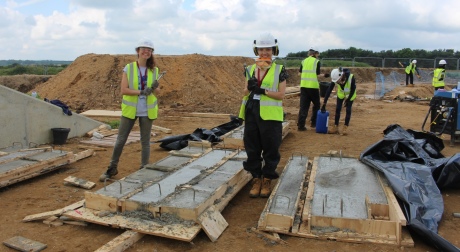 Over the years, Constructionarium has strengthened relations between Imperial and industry partners. Students were joined on site by several senior engineers from contracting and consultancy practices, including Morrisroe, Expedition Engineering, Godber and Co. and CH2M.
Over the years, Constructionarium has strengthened relations between Imperial and industry partners. Students were joined on site by several senior engineers from contracting and consultancy practices, including Morrisroe, Expedition Engineering, Godber and Co. and CH2M.
Most of the students had never set foot on a working site before, but after receiving health and safety briefings and professional training with power tools, they were soon coordinating and directing excavators, cranes and concrete trucks.
Hak Nazerali, a Health and Safety Engineer from Morrisroe, said: “Constructionarium is a great transition from theory to a hands-on, practical-learning experience. It helps the students to really understand time-frames and the process behind all the planning in construction.”
The physical nature of Constructionarium was a new concept for many of the students, who discussed the challenges they had envisaged for the week.
Student Alice Jackson said of the experience: “I never thought that contracting would be something I would be interested in, but this has been a once in a lifetime opportunity. I’ve had such a good time. The fact that you’re starting from scratch and you’re seeing all this being brought together, I can now truly understand why people would want to be a part of construction.”
Fellow student Jean Marc Feghali added: “It’s been like nothing we’ve encountered before. There are so many more things to think about when it’s real, particularly executing the project and keeping everyone safe on site.”
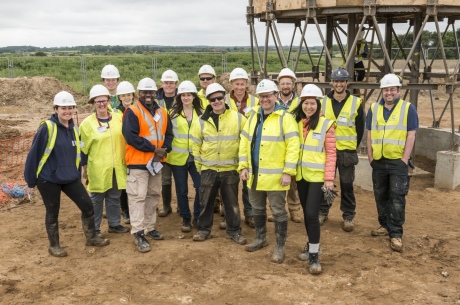
The team of staff on hand, including Imperial lecturers and technicians as well as engineers from industrial partners
Dr Sunday Popo-Ola, Research and Teaching Fellow and coordinator of the day said: “Constructionarium allows every student to taste the responsibilities of practical engineering, which converts students of engineering into student engineers. We are very proud of the success of this year’s students and of our teaching team. We could not do it without our industry partners.”The
Gherkin
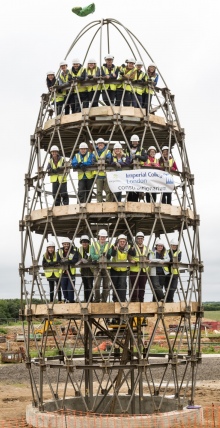 With 40 storeys reaching 180 metres into the sky, the Gherkin is one of the most recognisable skyscrapers in London. One team was challenged to build a 1 in 10 scale, four storey, 12 metre high replica of the tower, using prefabricated steel members connected in a diagrid form to a ringed concrete foundation. The students used over 1000 bolts to connect the steel shell-structure.
With 40 storeys reaching 180 metres into the sky, the Gherkin is one of the most recognisable skyscrapers in London. One team was challenged to build a 1 in 10 scale, four storey, 12 metre high replica of the tower, using prefabricated steel members connected in a diagrid form to a ringed concrete foundation. The students used over 1000 bolts to connect the steel shell-structure.
The team needed to perfect the calculations, surveying, and setting-out, or the building would be distorted. Speaking on site, student Alice Jackson said: “Fitting the curved timber formwork for the concrete ring foundation, and getting the steel reinforcement inside to fit was quite a challenge.”
The team impressed with their improvising skills when their vibrating poker (used to compact wet concrete) broke down, forcing them to manually churn the concrete with sticks. When the formwork was removed there were only a few minor blemishes on the concrete’s surface.
“The team’s concrete was of outstanding quality, considering they were unable to use a poker,” said Graham Hardwick, of Morrisroe.
The final tasks on Friday morning were to lift the preassembled steelwork on to the structure, using a 35-tonne crane, fit the floor slabs in at each level, and bolt them together.
Speaking from the summit of the completed Gherkin, student project manager Azhar Ali said: “We may not be on top of a real skyscraper, but this is the highest we’ve ever felt. Would I do all this again? Every day!”
Ravenspurn Oil Rig
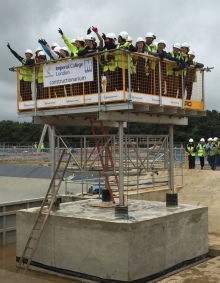 Ravenspurn is a 28,000 tonne oil platform in the North Sea, installed 80km off Britain. Developed by Arup Energy in 1989, the rig has a unique design which allows it to have two decks, whereas previously only one has been possible.
Ravenspurn is a 28,000 tonne oil platform in the North Sea, installed 80km off Britain. Developed by Arup Energy in 1989, the rig has a unique design which allows it to have two decks, whereas previously only one has been possible.
The Constructionarium students’ re-creation took place in a drydock separated from a lake by a dam and included a 4 metre square concrete base attached to a steel superstructure.
During construction some students had to sail into the 2 metre-deep lake and level the designated sinking location with gravel. The test of success was to fill the drydock with water before the dam was opened, so that the structure could float from the drydock to the prepared sinking location.
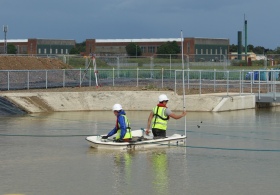 “We were casting the concrete for the base of the rig, which was going perfectly, but we then managed to pour too much concrete,” said student Teddy Taleongpong. “Our team project managers, Claudia Caravello and Christina Trigle, immediately set the whole team to work removing the excess concrete with buckets, which saved the project.”
“We were casting the concrete for the base of the rig, which was going perfectly, but we then managed to pour too much concrete,” said student Teddy Taleongpong. “Our team project managers, Claudia Caravello and Christina Trigle, immediately set the whole team to work removing the excess concrete with buckets, which saved the project.”
On the final morning of the Constructionarium week the team successfully flooded the drydock, and towed the oil rig to the centre of the lake, where, after a tense wait, the structure sank into position.
“I have loved the hands-on experience of Constructionarium,” Teddy said. “It’s helped to confirm even more that I want to be in engineering, and that I want to be working on site with macro-projects.”
Article text (excluding photos or graphics) © Imperial College London.
Photos and graphics subject to third party copyright used with permission or © Imperial College London.
Reporter
Melanie Hargreaves
Department of Civil and Environmental Engineering